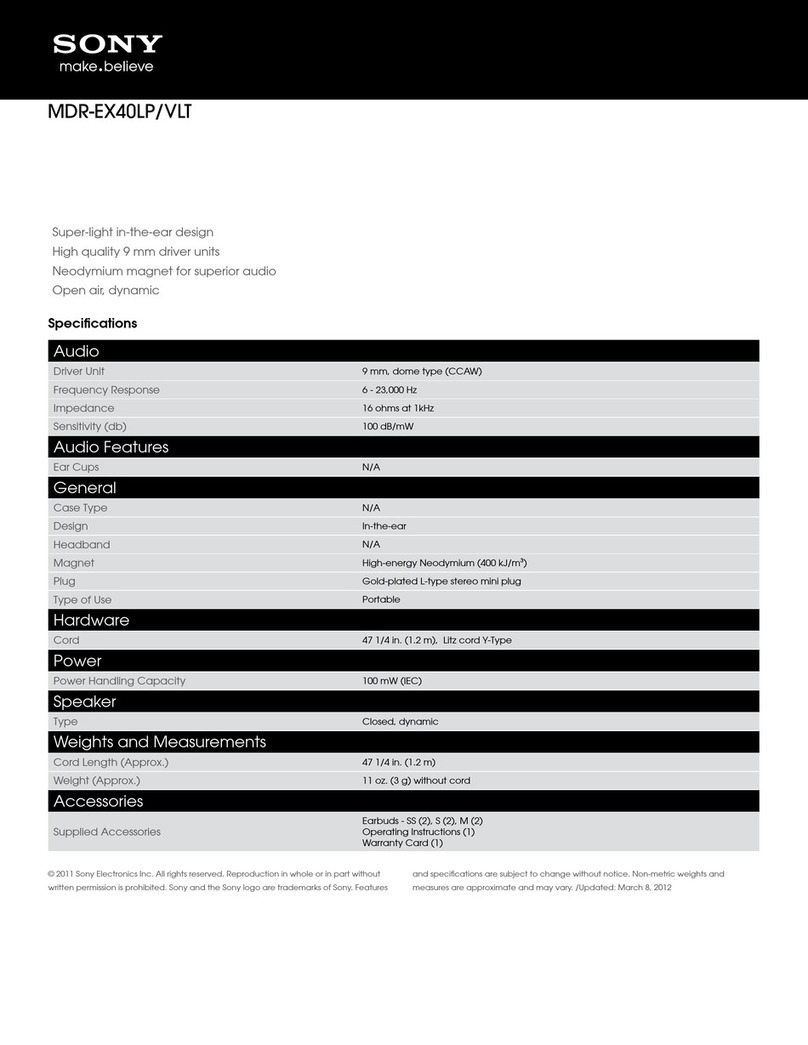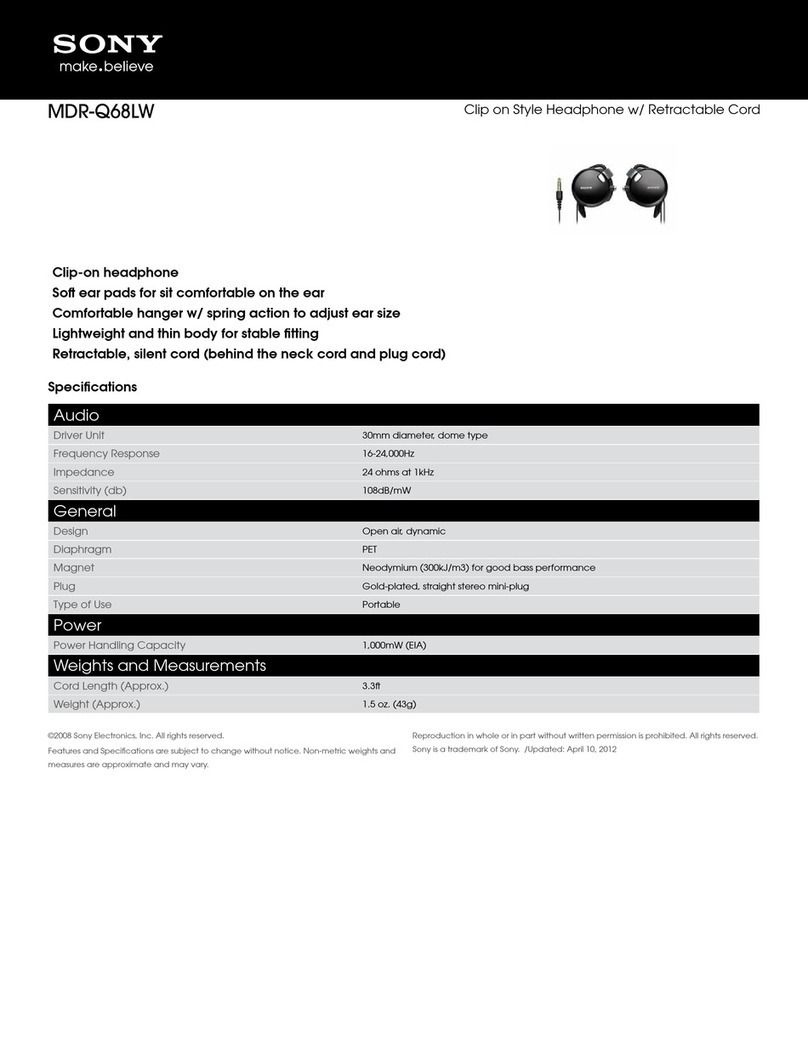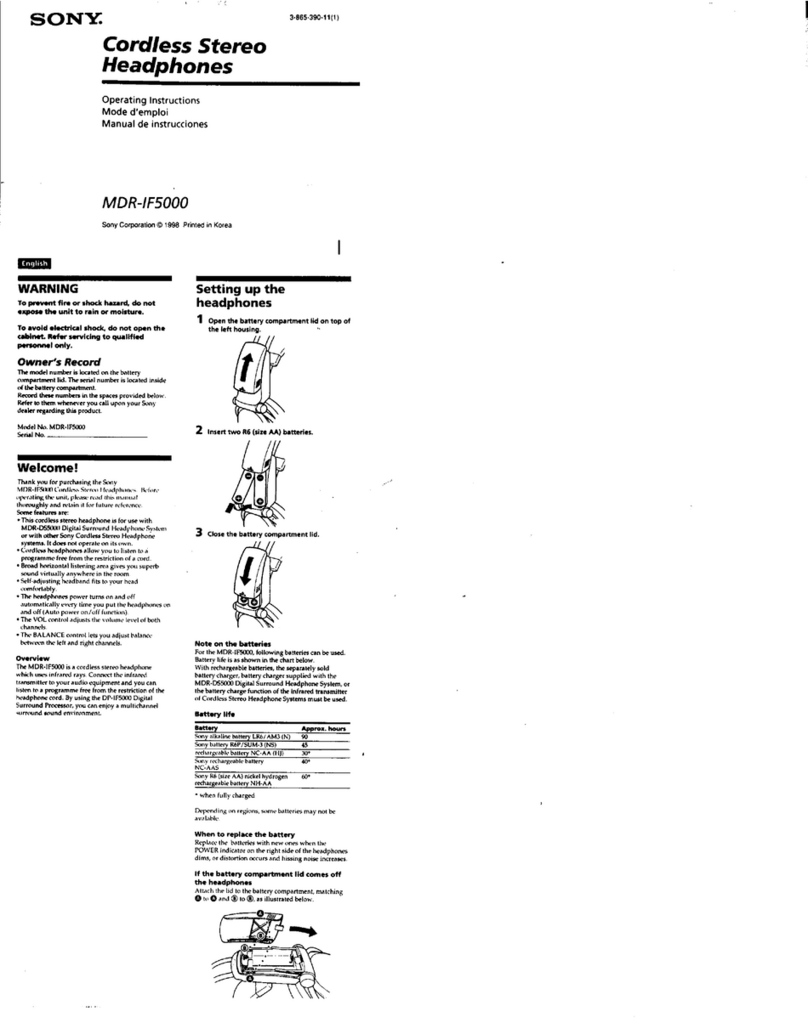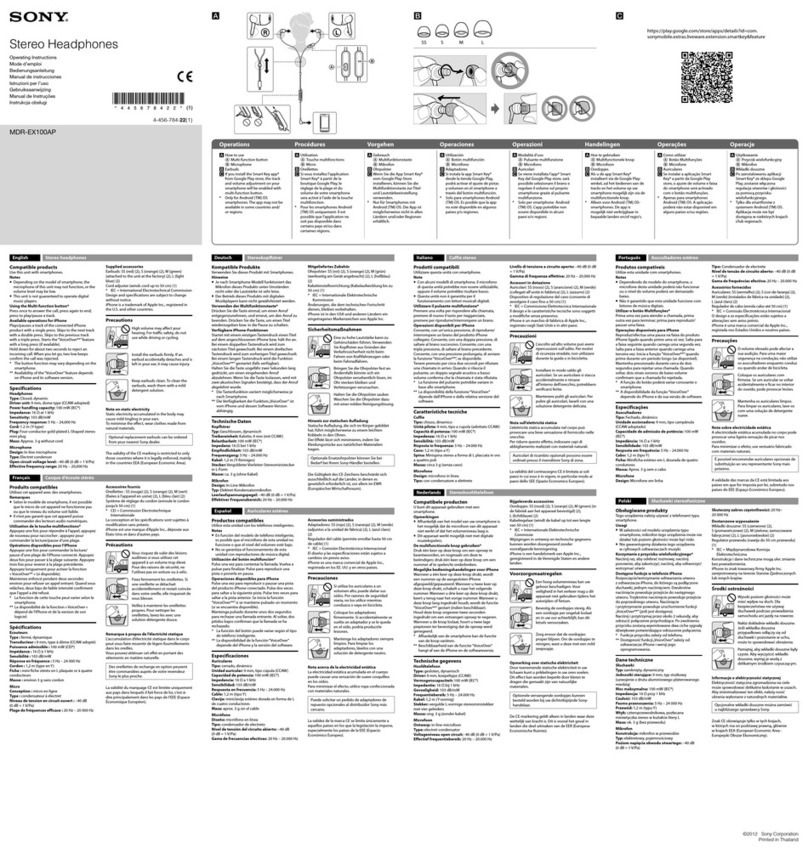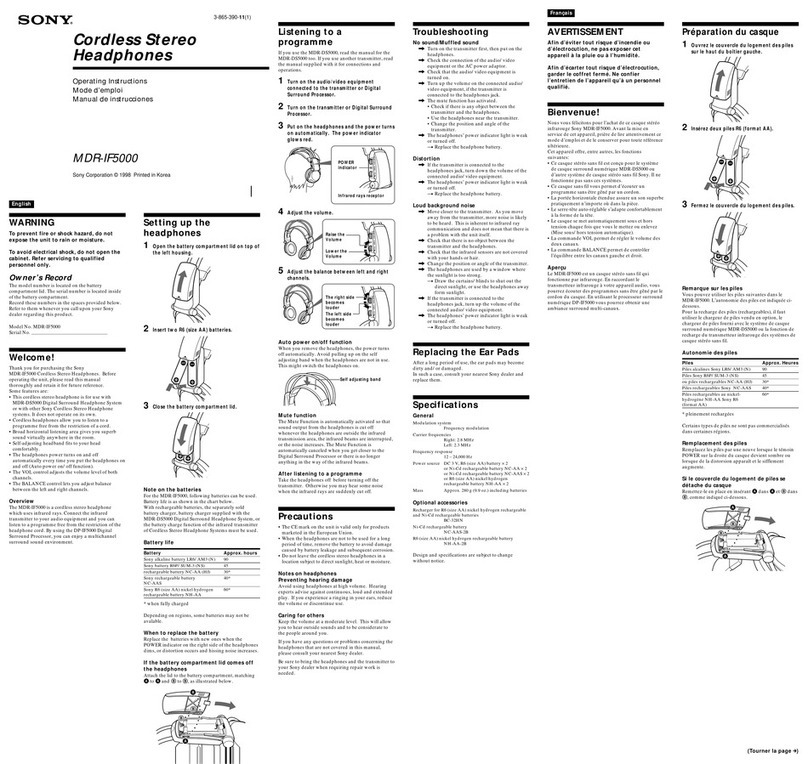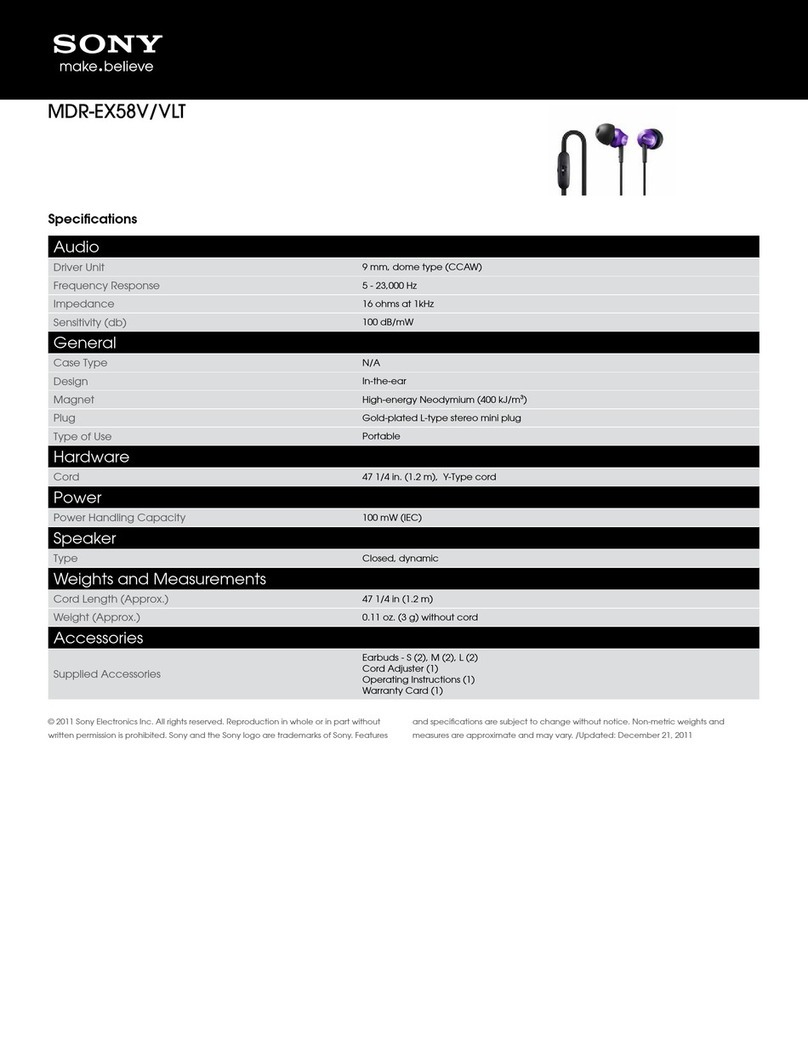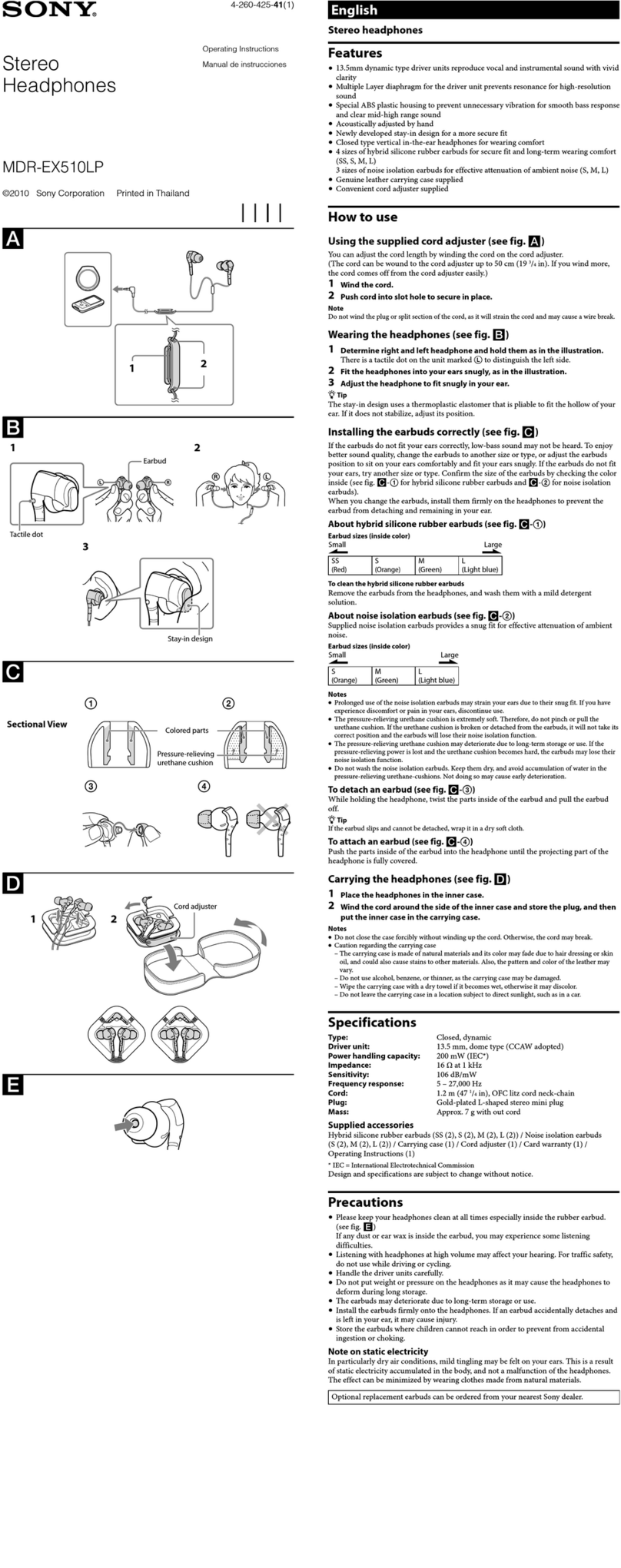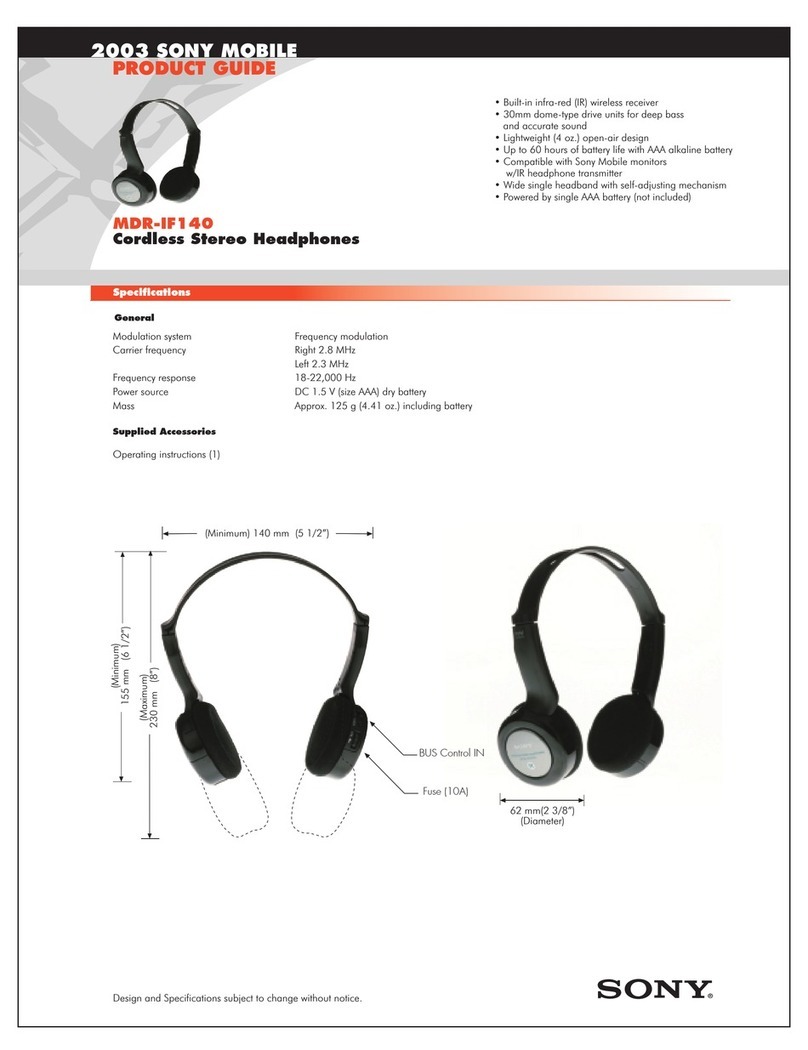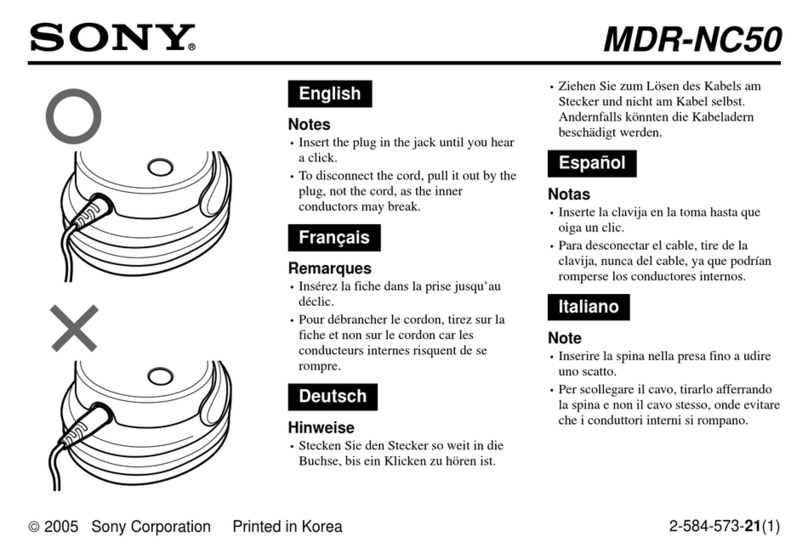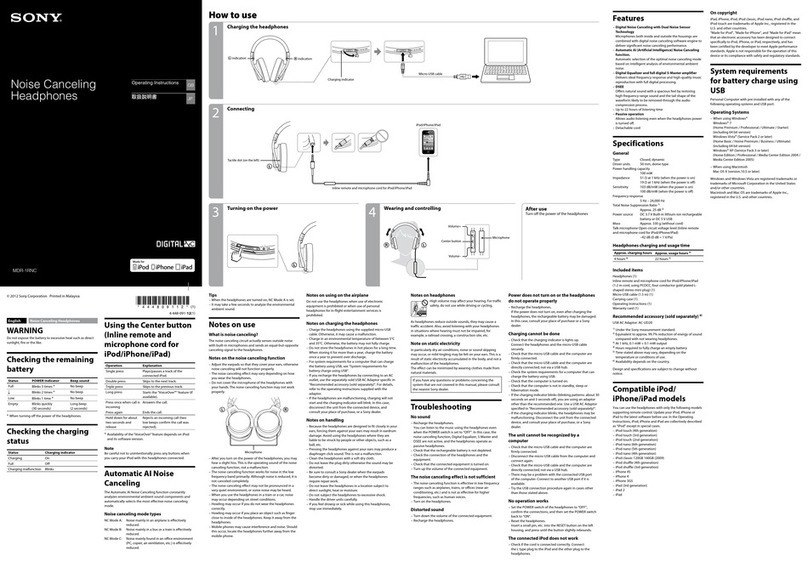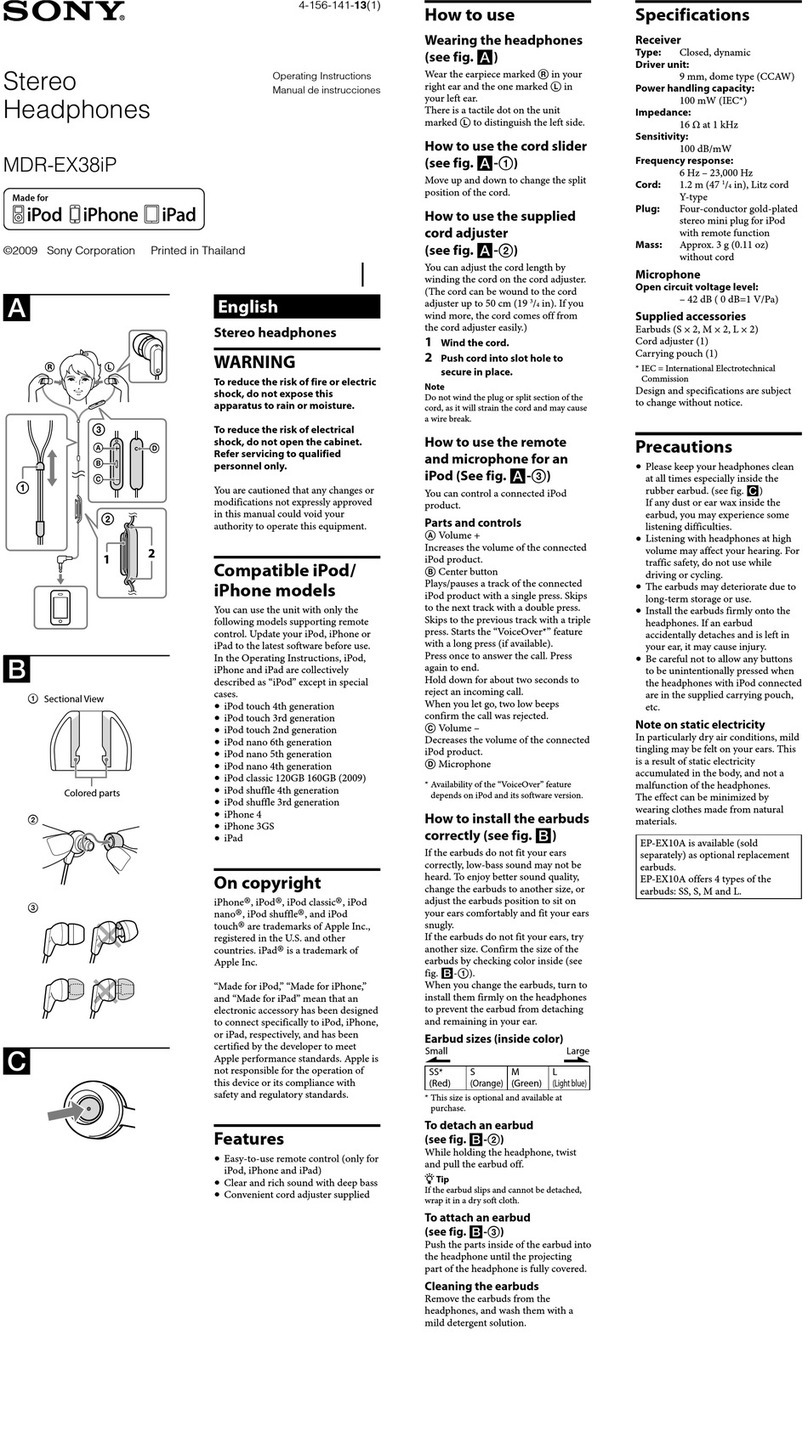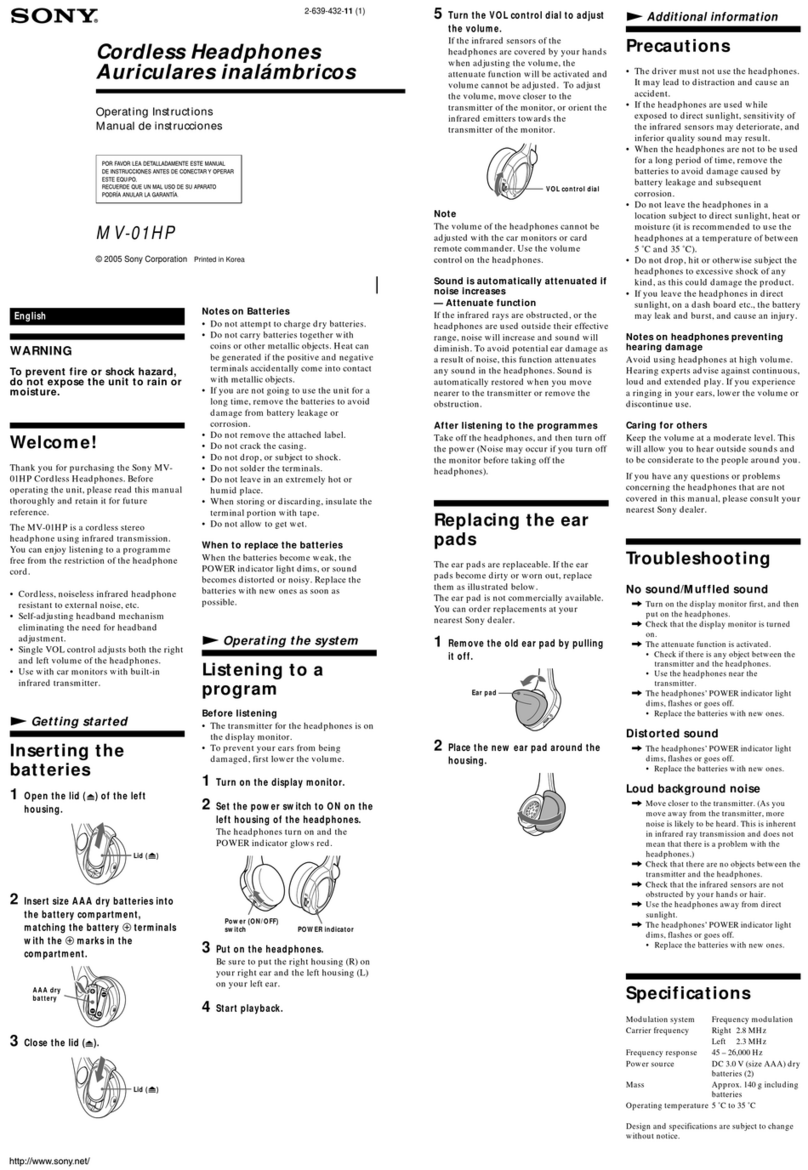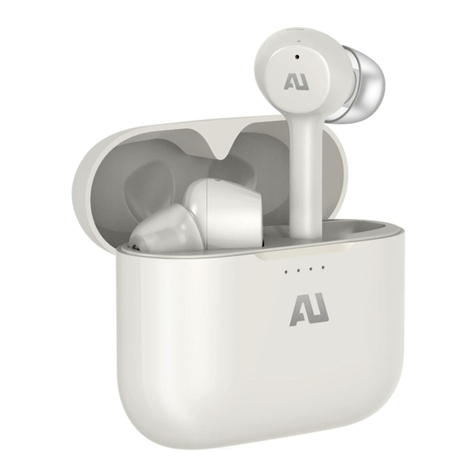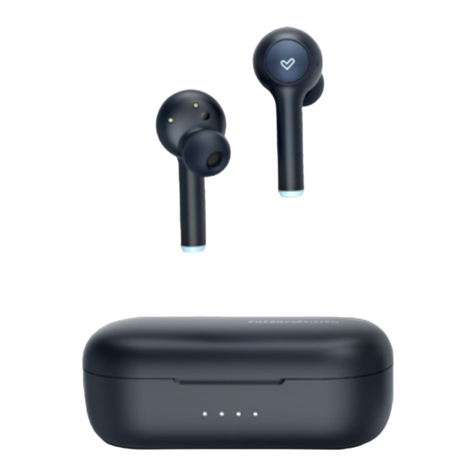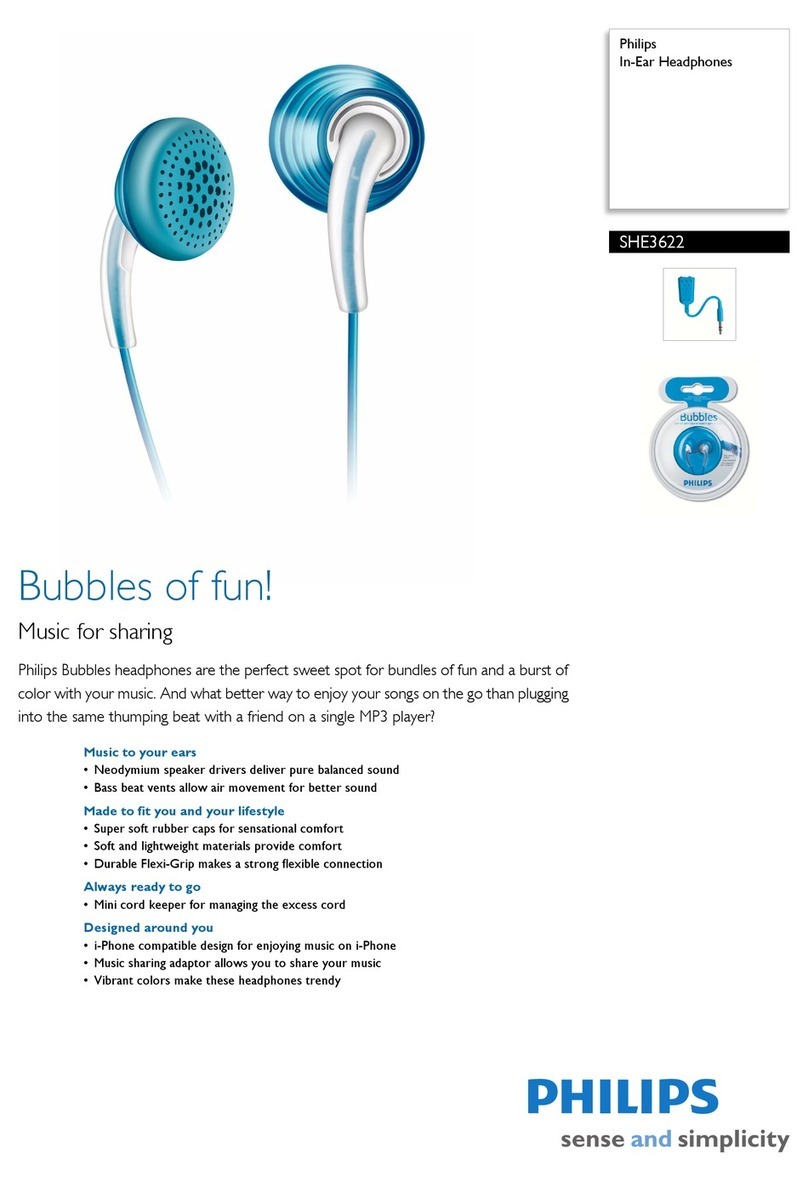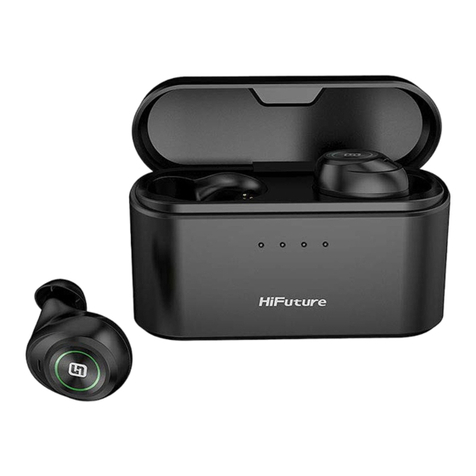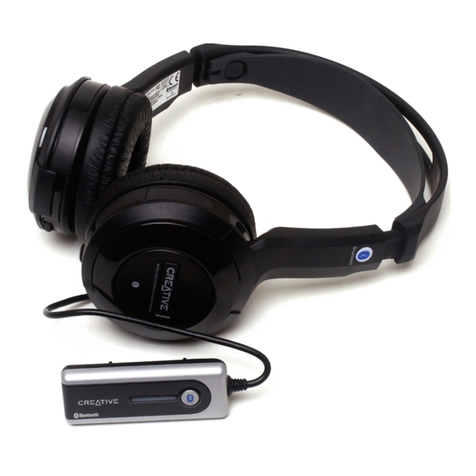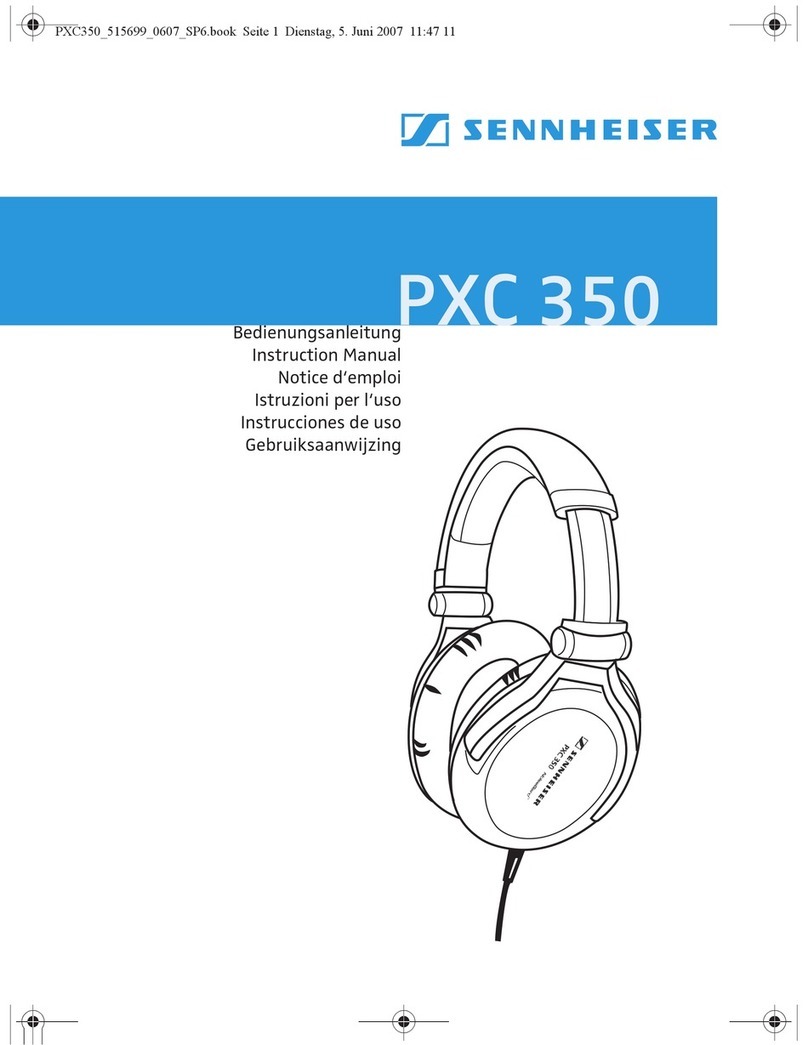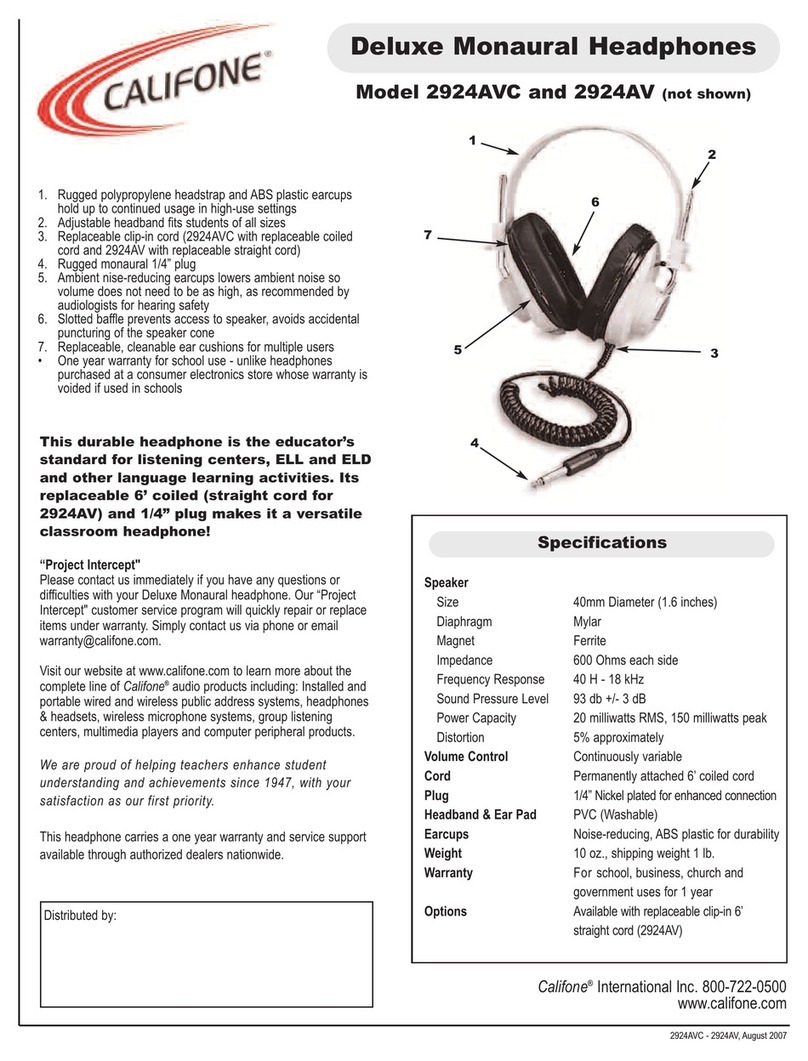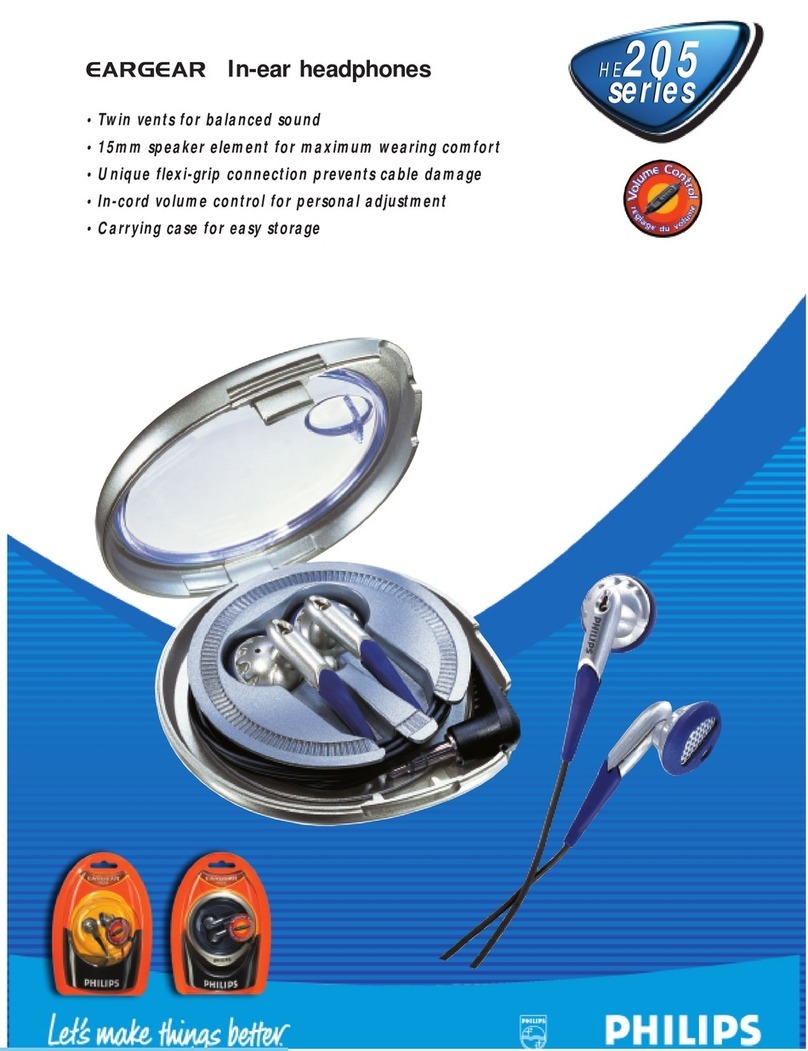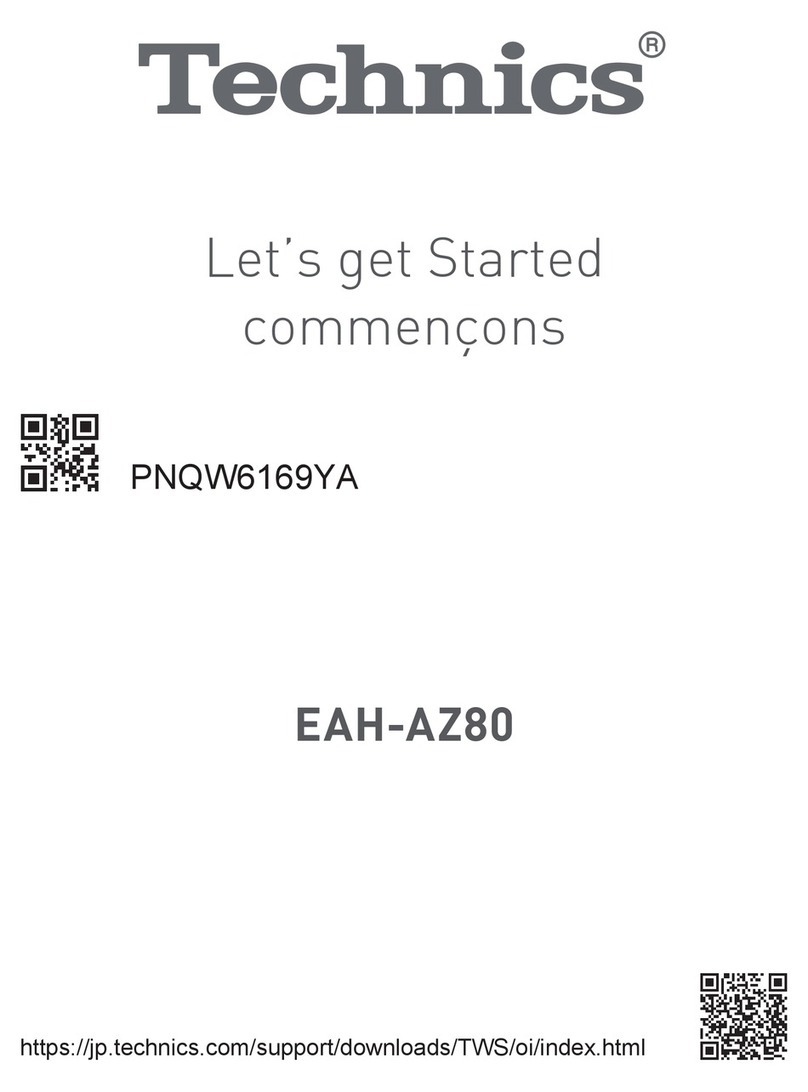MDR-NC500D
4
SECTION 2
GENERAL This section is extracted
from instruction manual.
When the rechargeable
battery is low
When the rechargeable battery is low, short beeps
sound from the unit for 8 seconds and the
POWER indicator blinks slowly.
When the battery level is getting lower, a long
beep sounds from the unit for 2 seconds and the
POWER indicator blinks quickly, and all
operations are stopped. Move the POWER switch
to “OFF” in this case.
[Tips
When the battery runs out, you can supply the power to
the headphones in one of the following ways:
• Connect the headphones to the AC power adaptor by
following the steps shown in “Charge the
headphones.”
You can use the headphones while charging.
• Use the supplied connecting cord with battery case.
See “How to use the connecting cord with battery
case” for details.
Using your AC power
adaptor abroad
You can use your AC power adaptor in any
country or area that uses 100 V to 240 V AC,
50/60 Hz, by connecting a plug adaptor. If the
country you visit employs a different shaped
socket, use the correct plug adaptor.
Consult your nearest travel bureau for the type of
plug adaptor needed for your trip.
Listening to music
1Connect the headphones to the AV
equipment.
* “WALKMAN” and “WALKMAN” logo are
registered trademarks of Sony Corporation.
Notes
• When connecting the cord, insert the plug into the
jack until the green portion of the plug disappears.
• To disconnect the cord, pull it out by the plug, not
the cord, as the inner conductors may break.
2Turn on the power on the right side of the
headphones.
The POWER indicator lights up in blue, and a
short beep sounds from the unit.
3Put on the headphones.
After confirming the cord on the left and the
POWER switch on the right, put on the
headphones.
Adjust the ear pads so as to cover your ears.
4Start playing on the AV equipment
connected to the headphones.
Note
Playback is not available when there is no
power.
5Set the POWER switch of the
headphones to “OFF,” and then set the
POWER switch of the battery case to
“ON.”
The POWER indicator on the battery case
lights up green.
See steps 2 to 4 of “Listening to music” for
the following setting steps.
After use, set the POWER switch of both the
headphones and the battery case to “OFF.”
[Tips
• The power supply of the rechargeable battery is
consumed first, unless the battery runs out.
• If you connect and turn on the connecting cord with
the battery case in advance when the rechargeable
battery is low, you can use the headphones
uninterrupted, even after the battery in the
headphones runs out.
Notes
• The use of manganese batteries is not recommended,
since this type of battery has an extremely short
usage time.
• The battery case supplies the power to the
headphones for operation purposes only. It does not
charge the internal rechargeable battery in the
headphones.
• The POWER indicator of the battery case becomes
dim when the battery life is reaching the limit.
Replace the battery with new ones at the time.
• The supplied connecting cord with battery case is
only for these headphones. Do not connect to other
equipment.
After use
Turn off the power of the headphones.
Flat Storage
T
he housings rotate to make them flat for easy
storage in the carrying case (supplied), or in a seat
pocket. Restore to their usual position before using.
3-3-
Putting the headphones
in the carrying case
Rotate the housings to be flat before putting them
in the carrying case.
Features
(US and Tourist models )
•Digital noise canceling headphones
with Sony’s unique DNC Software
Engine.
Creation of a high-precision canceling signal
delivers outstanding noise canceling
performance.
•AI (Artificial Intelligence) Noise
Canceling function.
Automatic selection of the optimal noise
canceling mode based on intelligent analysis of
environmental ambient noise.
•
Digital equalizer delivers ideal frequency
response and high-quality music
reproduction.
•High S/N ratio achieved through digital
signal processing.
•Lightweight design creates extremely
comfortable wearing fit.
Generous use of lightweight materials such as
Magnesium and A7075 aluminum alloy.
•Pressure relieving urethane cushion in
the earpad.
The earpad structure provides comfort without
stress even after extended use.
•Built-in monitor function lets you
silence the audio to listen outside.
Charge the headphones
The headphones contains a rechargeable Lithium-
Ion battery. Charge the battery before use.
Connect the supplied AC power adaptor to the DC
IN 6V jack on the headphones and an AC outlet.
The charge indicator lights up in orange and
charging starts.
Charging is completed after about three hours,
and the charge indicator goes out.
Disconnect the AC power adaptor after the
charging has finished.
Utilizing the AI Noise
Canceling
1Press the AI NC MODE button.
When you press the AI NC MODE
button
and
the POWER switch is set to “ON”, sounds
come from the headphones to inform you that
the unit has started analyzing ambient sound
components (approx. 3 seconds).
During analysis, sound reproduction from the
unit is stopped and the POWER indicator
lights in pink.
When analysis is completed, the most
effective noise canceling mode is set
automatically, and sound reproduction from
the headphones starts.
AI Noise Canceling
AI Noise Canceling is a useful function that
automatically selects one of the noise canceling
modes. This function provides the most effective
noise canceling mode by immediately analyzing
ambient sound components when the AI NC
MODE button is pressed.
[Tips
• When the power of the headphones is turned on,
mode A is set. (See “Noise canceling mode types,”
for details about Mode A.)
• Press the AI NC MODE button again to reset the
noise canceling mode if ambient noise has changed,
such as when you move outdoors from a room.
To set the noise canceling mode
manually
You can set the noise canceling mode manually
(manual noise canceling).
1Press and hold the AI NC MODE button
for more than one second.
Sounds ( ) come from the headphones to
inform you that manual noise canceling is set.
2Press the AI NC MODE button
repeatedly to change the mode type.
The POWER indicator blinks pink and a
beep(s) sound(s) from the headphones. After
that, the noise canceling mode is set. The
number of POWER indicator blinks and the
beep sounds depends on the mode selected.
See “Noise canceling mode types.”
[Tips
• Mode A is selected when manual noise canceling is
activated.
• To change from manual noise canceling to AI Noise
Canceling, press and hold the AI NC MODE button
for more than one second. When you hear the sounds
() to inform you of the change to AI Noise
Canceling, press the AI NC MODE button again.
Ambient analysis starts and the most effective noise
canceling mode is set automatically.
Noise canceling mode types
Mode names Number of POWER indicator
blinks (pink) and beep
sounds
A1
B2
C3
A:Noise mainly in an airplane is effectively reduced.
B: Noise mainly in a bus or a train is effectively
reduced.
C: Noise mainly found in an office environment (PC,
copier, air ventilation, etc.) is effectively reduced.
Hearing environmental
sound for safety
If the MONITOR
button
is pressed and held while
the POWER switch is set to ON, playback silences
then you can hear the surrounding environment.
Note
Environmental sound might not be heard if the
microphone is covered with your fingers.
When using in an
airplane
• The supplied plug adaptor can be connected to
the dual or stereo mini jacks in an airplane.
• Do not use the headphones when use of
electronic equipment is prohibited, or when use
of personal headphones for in-flight music
services are prohibited.
How to use the
connecting cord with
the battery case
You can continue to use the unit, even when the
rechargeable battery in the headphones runs out,
by connecting the supplied connecting cord with
battery case.
Use the connecting cord with battery case by
inserting two size AA alkaline batteries.
1Open the lid of the battery case.
2Insert two size AA alkaline batteries.
Make sure of direction, matching the F
marks in the case with those on the batteries.
3Close the lid.
4Connect the supplied connecting cord
with the battery case to both the
headphones and AV equipment.
Notes
• When connecting the cord, insert the plug fully into the
jack so that the green sign on the metal parts cannot be
seen.
• When disconnecting the cord, pull it out by holding the
plug. If the cord is pulled forcibly the wire may break.
3-
POWER
indicator
AI NC MODE
button
AV equipment
Headphones
Connecting cord with
battery case (supplied)
for dual jacks for stereo mini jacks
3-
POWER
indicator
POWER
switch
POWER switch
POWER indicator
3-
Monitor microphone
MONITOR
button
Headphones
To an AC outlet
AC power
adaptor
(supplied)
To DC IN
6V jack
Charge
indicator
Connecting cord
0.5 m (supplied)
When connecting
to the stereo mini
jack of the remote
control supplied
with a WALKMAN,
etc.
Remote
control
When connecting
to the stereo mini
jack of a
WALKMAN*, etc.
Headphones
Connecting
cord 1.5 m
(supplied)
Tactile dot
(on the left)
Features
(Except US and Tourist models )
•
Digital noise canceling headphones with
Sony’s unique DNC Software Engine.
Reduces approx. 99% of ambient noise by
creating a high-precision canceling signal.
•AI (Artificial Intelligence) Noise
Canceling function.
Automatic selection of the optimal noise
canceling mode based on intelligent analysis of
environmental ambient noise.
•Digital equalizer delivers ideal
frequency response and high-quality
music reproduction.
•High S/N ratio achieved through digital
signal processing.
•Lightweight design for extremely
comfortable wearing.
Generous use of lightweight materials such as
Magnesium and A7075 aluminum alloy.
•Pressure relieving urethane cushion in
the earpad.
The earpad structure provides comfort without
stress even after extended use.
•Built-in monitor function lets you
silence the audio to hear externally.
